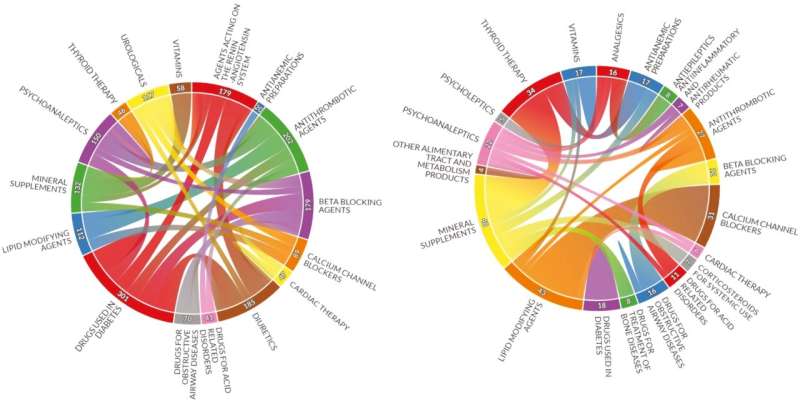Cancer patients face higher risks of drug interactions

Here's a scenario so common that it applies to nearly 92% of older adults with cancer: An individual comes in for treatment and reports taking several medications that might include a drug for high blood pressure or heart disease, an antidepressant, and something for diabetes. The person may also take frequent doses of Advil, over-the-counter pills to relieve heartburn or reflux, antihistamines, and vitamins and minerals. But, patients may not report these as often to the medical team.
This soupy concoction defines "polypharmacy," or the concurrent use of multiple medications—which can lead to harmful drug interactions, which is especially dangerous for cancer patients about to undergo therapy.
Even for individuals who do not have cancer, multiple medication use is fraught with risks and tricky to navigate because of the emotions involved, said Erika Ramsdale, M.D., a Wilmot Cancer Institute oncologist, geriatrics specialist, and data scientist who led a recent study on polypharmacy published in the journal The Oncologist.
"As doctors, we tell people to take medications but we don't always do a great job of following up," she said. "From the patient perspective, if it's determined that a medication is no longer needed, it's hard to stop taking it. There's a sense of, 'What will happen if I stop?' or 'Are you giving up on me?' A lot of uncertainty and emotions are tied up in this issue."
The more drugs and supplements a person takes, the higher the risk of inappropriate use and serious drug interactions, she said.
The fragmented nature of health care across specialties complicates the issue. "Sometimes, there is no quarterback," Ramsdale said, which can result in "prescribing cascades," where additional drugs are given to offset the adverse side effects of the original medications.
Wilmot researchers analyzed medication use in a nationwide sample of 718 adults with a mean age of 77 who had stage 3 or 4 cancer and other health conditions. They were looking for potentially inappropriate medications that have risks higher than benefits (known as PIMS), drug-drug interactions (DDI), and drug-cancer treatment interactions (DCI). The consequences of drug interactions include falls, functional decline, and death. Patients who take several medications are also more likely to have anxiety or depression.
Among the 718 patients, 70% were at risk of drug-drug interactions and 67% were taking at least one drug that was potentially inappropriate.
In fact, 61% of the patients were taking five or more medications before starting chemotherapy—and nearly 15% were taking 10 or more medications.
Other eye-catching facts:
- Nearly 68% of the patients had serious health issues besides cancer, requiring associated medications. Most common was cardiovascular disease. When a person has cancer combined with other ailments, there is a greater risk of toxicity from cancer treatments due to polypharmacy.
- Approximately 10% of hospital admissions for older adults are associated with hazardous drug interactions. Among older adults with cancer receiving chemotherapy, polypharmacy is associated with dramatic increases (up to 114%) in unplanned hospitalizations.
- Cholesterol-lowering medications, minerals, and thyroid therapy are most commonly involved in potential drug interactions.
- More than 25% of the medications used by the patients in the study were non-prescription—and these accounted for 40% of the potentially inappropriate medications detected by investigators.
- Common non-prescription remedies included vitamins and minerals, anti-anemic preparations such as ferrous sulfate, and drugs for acid-related disorders and constipation.
"Older adults may incorrectly assume that over-the-counter medications are safe for them," the authors wrote. "This study helps delineate the size and shape of a problem under-recognized by both providers and patients."
It's also an understudied problem, Ramsdale said—and the inclusion of over-the-counter medications is what sets Wilmot's data apart from previous research; most polypharmacy studies among cancer patients look only at prescription drugs.
The study highlights an opportunity for education and problem-solving, such as "deprescribing" some drugs.
Deprescribing is the planned reduction of medications to avoid harm. Doctors take into account the risks-versus-benefits of each medication and the patient's life expectancy. For example, statins that are taken for high cholesterol do not have an immediate effect. They are meant to be preventive and can take 10 years to have an impact. Therefore, if a patient is old and has incurable cancer, he or she may not need to take statins. (Discontinuing statins in this setting is supported by a landmark study, according to the Ramsdale publication.)
However, these conversations can be quite delicate, Ramsdale said. The goal is to promote better quality of life, and she is conducting a clinical trial to test the best way to intervene in cases of polypharmacy among older people with cancer.
More information: Erika Ramsdale et al, Polypharmacy, Potentially Inappropriate Medications, and Drug-Drug Interactions in Vulnerable Older Adults With Advanced Cancer Initiating Cancer Treatment, The Oncologist (2022). DOI: 10.1093/oncolo/oyac053




















